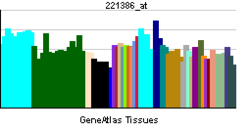- OR3A2
-
Olfactory receptor, family 3, subfamily A, member 2 Identifiers Symbols OR3A2; OLFRA04; OR17-14; OR17-228; OR228 External IDs MGI: 3030244 HomoloGene: 68262 GeneCards: OR3A2 Gene Gene Ontology Molecular function • receptor activity
• olfactory receptor activityCellular component • plasma membrane
• integral to plasma membraneBiological process • signal transduction
• sensory perception of chemical stimulus
• sensory perception of smell
• response to stimulusSources: Amigo / QuickGO RNA expression pattern 
More reference expression data Orthologs Species Human Mouse Entrez 4995 258703 Ensembl ENSG00000221882 ENSMUSG00000070379 UniProt P47893 n/a RefSeq (mRNA) NM_002551 NM_146708.1 RefSeq (protein) NP_002542 NP_666919.1 Location (UCSC) Chr 17:
3.18 – 3.18 MbChr 11:
73.97 – 73.97 MbPubMed search [1] [2] Olfactory receptor 3A2 is a protein that in humans is encoded by the OR3A2 gene.[1][2][3]
Olfactory receptors interact with odorant molecules in the nose, to initiate a neuronal response that triggers the perception of a smell. The olfactory receptor proteins are members of a large family of G-protein-coupled receptors (GPCR) arising from single coding-exon genes. Olfactory receptors share a 7-transmembrane domain structure with many neurotransmitter and hormone receptors and are responsible for the recognition and G protein-mediated transduction of odorant signals. The olfactory receptor gene family is the largest in the genome. The nomenclature assigned to the olfactory receptor genes and proteins for this organism is independent of other organisms.[3]
Contents
See also
References
- ^ Glusman G, Clifton S, Roe B, Lancet D (Feb 1997). "Sequence analysis in the olfactory receptor gene cluster on human chromosome 17: recombinatorial events affecting receptor diversity". Genomics 37 (2): 147–60. doi:10.1006/geno.1996.0536. PMID 8921386.
- ^ Glusman G, Sosinsky A, Ben-Asher E, Avidan N, Sonkin D, Bahar A, Rosenthal A, Clifton S, Roe B, Ferraz C, Demaille J, Lancet D (Apr 2000). "Sequence, structure, and evolution of a complete human olfactory receptor gene cluster". Genomics 63 (2): 227–45. doi:10.1006/geno.1999.6030. PMID 10673334.
- ^ a b "Entrez Gene: OR3A2 olfactory receptor, family 3, subfamily A, member 2". http://www.ncbi.nlm.nih.gov/sites/entrez?Db=gene&Cmd=ShowDetailView&TermToSearch=4995.
Further reading
- Ben-Arie N, Lancet D, Taylor C, et al. (1994). "Olfactory receptor gene cluster on human chromosome 17: possible duplication of an ancestral receptor repertoire.". Hum. Mol. Genet. 3 (2): 229–35. doi:10.1093/hmg/3.2.229. PMID 8004088.
- Rouquier S, Taviaux S, Trask BJ, et al. (1998). "Distribution of olfactory receptor genes in the human genome.". Nat. Genet. 18 (3): 243–50. doi:10.1038/ng0398-243. PMID 9500546.
- Strausberg RL, Feingold EA, Grouse LH, et al. (2003). "Generation and initial analysis of more than 15,000 full-length human and mouse cDNA sequences.". Proc. Natl. Acad. Sci. U.S.A. 99 (26): 16899–903. doi:10.1073/pnas.242603899. PMC 139241. PMID 12477932. http://www.pubmedcentral.nih.gov/articlerender.fcgi?tool=pmcentrez&artid=139241.
- Malnic B, Godfrey PA, Buck LB (2004). "The human olfactory receptor gene family.". Proc. Natl. Acad. Sci. U.S.A. 101 (8): 2584–9. doi:10.1073/pnas.0307882100. PMC 356993. PMID 14983052. http://www.pubmedcentral.nih.gov/articlerender.fcgi?tool=pmcentrez&artid=356993.
External links
This article incorporates text from the United States National Library of Medicine, which is in the public domain.
Class II
(tetrapod specific receptors)Family 1Family 2A1 · A2 · A4 · A5 · A7 · A12 · A14 · A25 · A42 · AE1 · AG1 · AG2 · AJ1 · AK2 · AP1 · AT4 · B2 · B3 · B6 · B8 · B11 · C1 · C3 · D2 · D3 · F1 · F2 · G2 · G3 · G6 · H1 · H2 · J1 · J2 · J3 · K2 · L2 · L3 · L5 · L8 · L13 · M2 · M3 · M4 · M5 · M7 · S2 · T1 · T2 · T3 · T4 · T5 · T6 · T8 · T10 · T11 · T12 · T27 · T29 · T33 · T34 · T35 · V1 · V2 · W1 · W3 · W5 · Y1 · Z1
Family 3Family 4Family 5Family 6Family 7Family 8Family 9Family 10Family 11Family 12Family 13Categories:- Human proteins
- Transmembrane receptor stubs
- G protein coupled receptors
Wikimedia Foundation. 2010.
